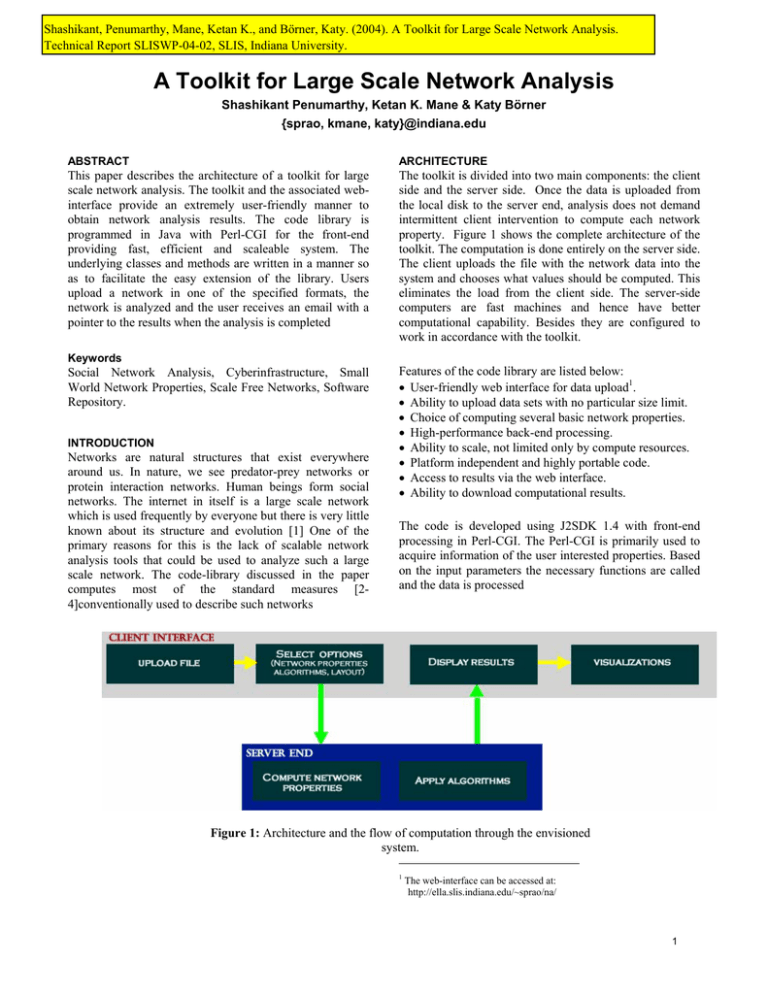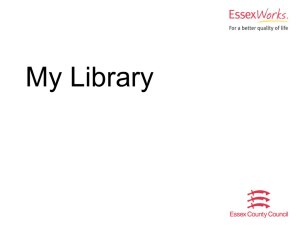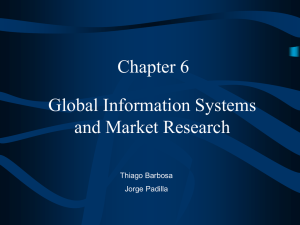Document 10765915
advertisement

Shashikant, Penumarthy, Mane, Ketan K., and Börner, Katy. (2004). A Toolkit for Large Scale Network Analysis.
Technical Report SLISWP-04-02, SLIS, Indiana University.
A Toolkit for Large Scale Network Analysis
Shashikant Penumarthy, Ketan K. Mane & Katy Börner
{sprao, kmane, katy}@indiana.edu
ABSTRACT
ARCHITECTURE
This paper describes the architecture of a toolkit for large
scale network analysis. The toolkit and the associated webinterface provide an extremely user-friendly manner to
obtain network analysis results. The code library is
programmed in Java with Perl-CGI for the front-end
providing fast, efficient and scaleable system. The
underlying classes and methods are written in a manner so
as to facilitate the easy extension of the library. Users
upload a network in one of the specified formats, the
network is analyzed and the user receives an email with a
pointer to the results when the analysis is completed
The toolkit is divided into two main components: the client
side and the server side. Once the data is uploaded from
the local disk to the server end, analysis does not demand
intermittent client intervention to compute each network
property. Figure 1 shows the complete architecture of the
toolkit. The computation is done entirely on the server side.
The client uploads the file with the network data into the
system and chooses what values should be computed. This
eliminates the load from the client side. The server-side
computers are fast machines and hence have better
computational capability. Besides they are configured to
work in accordance with the toolkit.
Keywords
Social Network Analysis, Cyberinfrastructure, Small
World Network Properties, Scale Free Networks, Software
Repository.
INTRODUCTION
Networks are natural structures that exist everywhere
around us. In nature, we see predator-prey networks or
protein interaction networks. Human beings form social
networks. The internet in itself is a large scale network
which is used frequently by everyone but there is very little
known about its structure and evolution [1] One of the
primary reasons for this is the lack of scalable network
analysis tools that could be used to analyze such a large
scale network. The code-library discussed in the paper
computes most of the standard measures [24]conventionally used to describe such networks
Features of the code library are listed below:
• User-friendly web interface for data upload1.
• Ability to upload data sets with no particular size limit.
• Choice of computing several basic network properties.
• High-performance back-end processing.
• Ability to scale, not limited only by compute resources.
• Platform independent and highly portable code.
• Access to results via the web interface.
• Ability to download computational results.
The code is developed using J2SDK 1.4 with front-end
processing in Perl-CGI. The Perl-CGI is primarily used to
acquire information of the user interested properties. Based
on the input parameters the necessary functions are called
and the data is processed
Figure 1: Architecture and the flow of computation through the envisioned
system.
1
The web-interface can be accessed at:
http://ella.slis.indiana.edu/~sprao/na/
1
DATA FORMATS
The current version supports two formats:
I) Barabási Format:
The movie actor format as used by Albert-László
Barabási2. A sample of the format is shown below:
3
4
4
4
4
4
5225
590 5679
7186 3862 4615 6277
The first column is the primary node and the other columns
are considered to be its neighbors. The user must provide
information on whether the input network is directed or
undirected through the web interface. Details about how
the program interprets this file to form arcs and edges are
on the network analysis website.
II) PAJEK3 Format:
A sample of the format is shown below:
*vertices 3084
1 "GILBERT GN"
2 "NARIN F"
3 "INHABER H"
4 "DEBBEAVER D"
5 "HUSTOPECKY J"
6 "VLACHY J"
…
*arcslist
1
53
54
57
60
105 106 149 225 487 506
704 812 1119 1484 1496 1749
The first part of this file has information about the vertices
and the latter part of the file contains information about the
edges that exist between these vertices. Details about this
format are on the Pajek[5] website.
CLIENT-SIDE WEB INTERFACE
The client side web interface allows the user to select the
data format, the properties to be computed and algorithms
to be applied to the network. For a novice, the network
property definitions [6] are provided. Once the user
submits the request, the processing is moved to the backend and no more intervention by the user is required. When
the computation finishes, an e-mail is sent out to the user at
the e-mail address obtained during the upload process
informing him/her that the results are ready to be viewed
and downloaded.
New users must register when using this toolkit for the first
time. The code is being released under the GNU LGPL.
2
The Movie actor data set is available online at:
http://www.nd.edu/~networks/database/index.html
3
PAJEK is available online at:
http://vlado.fmf.uni-lj.si/pub/networks/pajek/
New users get a username and password which they can
then use to login to the system and to access the analysis
results. Please note that currently we do not archive the
datasets that users upload. Hence, whenever the user
uploads a dataset, the user’s previous results are erased.
SERVER-SIDE CODE LIBRARY
The server side code consists of Java code which is
invoked using the CGI script that is responsible for
processing of client entered information at the front-end.
The code library utilizes the following external libraries:
I) JUNG – Java Universal Network/Graph Framework.[7]
This is a code library written in Java that enables the
creation and manipulation of graphs.
II) CERN Colt – This is a high-performance scientific
computation library written in Java that provides extremely
fast methods for statistical and mathematical operations.
III) Xerces – This is a utility library that provides interconvertibility between the internal graph representation and
XML. This library is currently not being used. The aim is
to eventually provide all graphs and sub-graphs obtained
using this toolkit in GraphML.
The server side code is written in the form of Java
interfaces and classes that perform the following functions:
• Specify the instantiation and deletion of objects.
• Specify the internal representation of networks as graphs.
• Provide standard prototypes for the methods for
computation of network properties.
• Provide a seamless way to integrate the code library with
the third-party libraries.
• Provide a scaleable and uniform manner for using and
extending the functionality of the library.
The package hierarchy is given below:4
src/edu/iu/iv/analysis
src/edu/iu/iv/analysis/NetworkProperties
src/edu/iu/iv/analysis/NetworkAnalysis
src/edu/iu/iv/analysis/PFNet5
src/edu/iu/iv/clustering6
src/edu/iu/iv/clustering/BC
src/edu/iu/iv/clustering/Ward
src/edu/iu/iv/layout/7
src/edu/iu/iv/layout/KKLayout
src/edu/iu/iv/layout/FRLayout
4
The JavaDoc for this code library is available at:
http://ella.slis.indiana.edu/~sprao/na/javadoc/
5
This is currently not available since it is impractical to apply PFNet to
networks exceeding 300 nodes.
6
This section has been implemented in the IV Repository.
7
This is future work.
2
EXAMPLE
We are presenting the analysis of a ‘Small World’ network,
a selection of citation networks from Garfield’s collection8.
The analysis results can be accessed online in the following
format (this result is for the ‘Small World’ network data
set)
Number of nodes 1059
Number of Arcs 4913
Max in-degree 89
Max out-degree 232
Number of loops 0
Diameter 11
Number of isolated vertices 35
Size of largest weakly connected component 1024
Number of non-trivial weakly connected components 36
Clustering coefficient (Watts-Strogatz) 0.4443
Clustering coefficient (Newman) 0.0938
Scale free exponent
In-degree -1.6879
Out-degree -1.6879
In Degree Histogram sprao_indegree_histogram.txt
Out Degree Histogram sprao_outdegree_histogram.txt
The result page has a table containing all the requested
values as well as network links to download files. There are
differences in the manner in which certain network
measures are interpreted. We are working with researchers
in this field to ensure that network analysis toolkit uses the
standard way in which network measures are calculated
and interpreted.
CHALLENGES AND OPPORTUNITIES
A major challenge in this project has been to get standard
and widely accepted definitions for the properties
computed using this code library. There seems to be a
significant inconsistency in the manner in which these
measures are defined and interpreted especially between
the social
8
networks community and the physics community. We have
tried to provide all the accepted measures to enable
comparison of these values. A second challenge has been
to make the algorithms as scaleable as possible and this has
been made possible by the code library that we are using to
analyze the networks. The code is limited only by the
amount of available compute resources.
Future work includes providing a large number of popular
and useful algorithms to be applied to large-scale networks
and a major visualization component.
ACKNOWLEDGMENTS
We thank Katy Börner for her constant support and
encouragement, Filippo Menczer for making available to us
a preprint of a chapter from the Vespignani’s book, Steve
Borgatts for providing sample UCINet code and input and
the developers of JUNG for making available their
excellent library.
REFERENCES
1. Albert, R., Barabasi, A. L., Statistical mechanics of
complex networks. cond-mat/0106096, 2002.
2. Newman, M.E.J.A., A Study of Scientific Co-authorship
networks. . Journal Physics Review, 2000. 28.
3. Newman, M.E.J., The structure of scientific
collaboration networks. arXiv:cond-mat/0007214 v1,
2000. 12.
4. Watts, D.J.a.S., S. H., Collective dynamics of 'smallworld' networks. Nature, 1998. 393: p. 440-442.
5. V. Batagelj, A.M., Pajek - Program for Large Network
Analysis. Connections, 1998. 21(2): p. 47-57.
6. Weisstein's, E., World of Mathematics.
http://mathworld.wolfram.com.
7. JUNG, Java Universal Network/Graph Framework.
http://jung.sourceforge.net.
Garfield Collection for Networks is available online at
http://vlado.fmf.unilj.si/pub/networks/ data/cite/
3



![Service Coordination Toolkit Transition Planning Checklist [ DOC ]](http://s3.studylib.net/store/data/006933472_1-c85cecf2cfb8d9a7f8ddf8ceba8acaf8-300x300.png)
